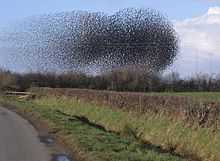Active matter
Active matter is defined as being systems made of many objects, each of which consumes energy in order to move,[1] i.e., these objects are self-propelled particles. Examples of active matter are schools of fish, flocks of birds, and self-organising energy consuming polymers such as microtubules and actin, both of which are part of the cytoskeleton of living cells. Most examples of active matter are biological in origin. It is a relatively new field in soft matter physics, perhaps the earliest well studied model, the Vicsek model, dates from 1995.[2]

The flock of starlings acting as a swarm. - geograph.org.uk - 124593
References
- ↑ Marcetti, M. C.; Joanny, J.F.; Ramaswamy, S.; Liverpool, T. B.; Prost, J.; Rao, M.; Adita Simha, R. (2012). "Hydrodynamics of soft active matter". Reviews of Modern Physics 85: 1143–1189. arXiv:cond-mat/0611743. Bibcode:2013RvMP...85.1143M. doi:10.1103/RevModPhys.85.1143.
- ↑ Vicsek, T.; Czirok, A.; Ben-Jacob, E.; Cohen, I.; Shochet, O. (1995). "Novel type of phase transition in a system of self-driven particles". Physical Review Letters 75 (6): 1226–1229. arXiv:cond-mat/0611743. Bibcode:1995PhRvL..75.1226V. doi:10.1103/PhysRevLett.75.1226. PMID 10060237.